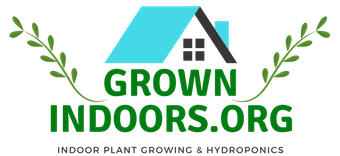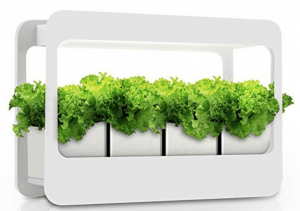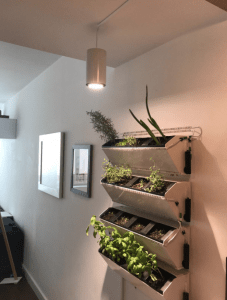Are you looking to bring some life and color into your home but don’t want to deal with the hassle of an outdoor garden? Look no further than indoor gardening!
Posts
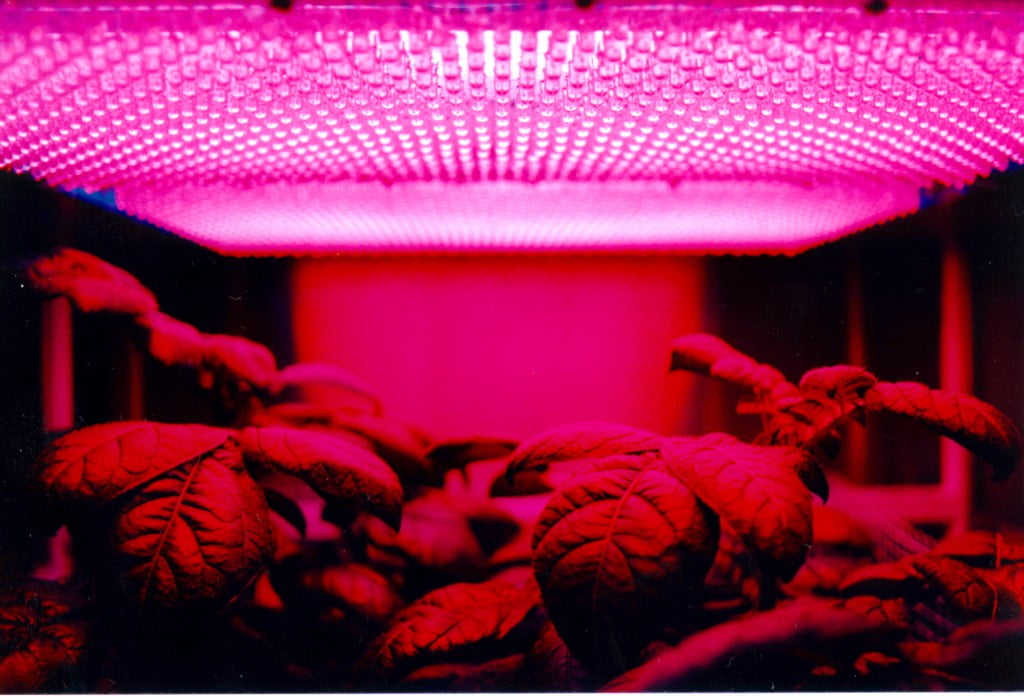 Indoor gardening ranges from a potted plant hanging by the window to full-fledged hydroponic systems with grow lights, nutrient and water delivery systems and sensors. The ideal setup for you depends on what you want to raise and the value you place on the crops.
Indoor gardening ranges from a potted plant hanging by the window to full-fledged hydroponic systems with grow lights, nutrient and water delivery systems and sensors. The ideal setup for you depends on what you want to raise and the value you place on the crops.
What Are the Benefits of Indoor Gardening with Grow Lights?
One of the top benefits of indoor gardening with artificial lighting is that you can grow plants out of season. It’s so cool because you can expose flowering plants to red light for example, and watch them bloom, just as if they were planted outside because you are providing the right conditions for growth. This benefit allows you to grow greens and blooms that usually grow in the spring or summer in the winter time.
Grow lights that let you put out specific wavelengths allow you to optimize for leaf growth or flowers. You end up with a higher yield for the part of the plant you want.
Another benefit of indoor gardening under grow lights is that you can grow plants that don’t normally grow in your area where you live at. This means that semi-tropical and tropical blooms could grow in your indoor garden even though they would never have a chance if raised outside.
 Another awesome benefit and this was a benefit that really excited me when I first started indoor gardening and it’s that you can control conditions to optimize your plants for certain traits. This means that you can raise lettuce and other leafy vegetables indoors to maximize for maximum yield and you will not have to worry about bugs to eat up and kill those plants.
Another awesome benefit and this was a benefit that really excited me when I first started indoor gardening and it’s that you can control conditions to optimize your plants for certain traits. This means that you can raise lettuce and other leafy vegetables indoors to maximize for maximum yield and you will not have to worry about bugs to eat up and kill those plants.
As we’ll discuss a bit later in the article in more detail, but another benefit depending on the lights you select, you could end up with local heat sources that keep semi-tropical and tropical plants warm even though they are sitting in an apartment that is constantly 70 degrees Fahrenheit inside.
Understanding Your Options with Grow Lights
The Benefits Of Using LED Grow Lights
LED grow lights such as the Hydrogalaxy 300w or 600w use a fraction of the power of other lighting technologies out there right now. For greenhouses, you could save up to half the energy you would need for HPS lights.
However, you need to be careful about the amount of light the LEDs release. Some of the LEDs offered as energy efficient are cheap and don’t put out as much light as other grow lights, with a number of them not even putting out enough light for the flowering phase. What I learned is that you can avoid this problem by selecting LED grow lights that put out at least 2.0 micromoles per Watt.
Durability of LED Grow Lights
One of the main benefits of using LED lights is that they last a lot longer than conventional or fluorescent lights. They don’t suddenly stop working, either, but dim slowly when their lifespan is being reached. Many LED Grow Lights today have auto shut off timers or programmable timers when you want the lights on, dimmed, or off.
Some nerd specs here, but it’s important to know and that is that LED lights put out light wavelengths ideal for photosynthesis; HPS lights, the traditional alternative, don’t put out light on the 400-500 and 600-700 nm range that is ideal for growing plants. You can also find LED lights that put out light in specific spectra like blue or deep red.
Daisy Chain Them Baby’s For Extra Coverage
 There is the matter of simplified lighting system designs, since you can use them in vertical systems, inter-lighting designs or ceiling lights. And many LED systems such as the Hydrogalaxy 300 can be daisy-chained, simplifying connected via wires that never touch the ground.
There is the matter of simplified lighting system designs, since you can use them in vertical systems, inter-lighting designs or ceiling lights. And many LED systems such as the Hydrogalaxy 300 can be daisy-chained, simplifying connected via wires that never touch the ground.
Heat Control and Economical Designs
LED lights don’t put out much heat either which is a plus. These lights are economical, producing more light per watt than fluorescents or HIDs.
If you want to expose plants to 24 hour light to accelerate growth, LED lights are the best choice. And if environmental issues are a factor, the fact that these lights don’t contain toxic substances like mercury is a plus.
Incandescent Lighting
Incandescent lights can be utilized as indoor grow lights in a few cases. They’re too hot to be right next to delicate plants though. They naturally put out a lot of light on the red side of the light spectrum but not the blue, so it can fuel growth of leafy greens and an herb garden but won’t be as good for woody plants.
You want blue light if fueling growth in the vegetative stage. You can use these to supplement natural light for your window herb garden and seedlings if not too close. The downside for these bulbs is their relatively high energy consumption.
Fluorescent Lighting
 Fluorescent lights have the benefits of energy efficiency and low heat generation. They also produce light across a broad spectrum. The downside is that they don’t put out a lot of light, so they work best as supplementary lights for plants that need more natural light than they’re getting.
Fluorescent lights have the benefits of energy efficiency and low heat generation. They also produce light across a broad spectrum. The downside is that they don’t put out a lot of light, so they work best as supplementary lights for plants that need more natural light than they’re getting.
Fluorescent lights are not good enough if you have sun loving plants that need high intensive lighting. Nor do they put out much in the red spectrum, something you want if maximizing leaf growth is what your looking for.
Fluorescent grow lights are manufactured and sell well due to their usefulness. In case your didn’t know fluorescent grow lights are measured by their diameter. A T5 is best for propagation of plants while they don’t work well for vegetative and flowering plants.
HID Lights (High Intensive Discharge)
A HID or high intensive discharge light uses large bulbs that ignite gas inside the bulb. HIDs may be high pressure sodium lights (HPS) or metal halides (MH). In either case, they use tungsten electrodes to ignite the gas within the bulb.
Metal halide lamps put out a lot of blue light which are ideal for the vegetative stage of plants. High pressure sodium lamps put out more light in the red spectrum, and these are ideal for flowering plants.
HID lamps create much more usable light than fluorescent bulbs. They’re often dimmable, though the same is true of LEDs. The downside of these lamps is the amount of heat they generate; they can’t be put a few inches above your plants without risking either burning them with heat or sun-burning them with the intensity of light.
What Is A Ballast?
Another consideration is the ballast; nearly any LED light can be plugged into ballasts designed for LED lights whereas some ballast only work with MH or HPS lights. If you want a mix of lights, you need several ballasts.
Reflectors
And then there is the need for extra hardware like reflectors. These bulbs do contain mercury, so you need to be careful not to break them while changing them out. If you’re using HPS lights, expect to need a ventilation system and AC system in your grow room. Conversely, LED lights get by with a fan that is often built into the ballast.
Light Emitting Ceramics
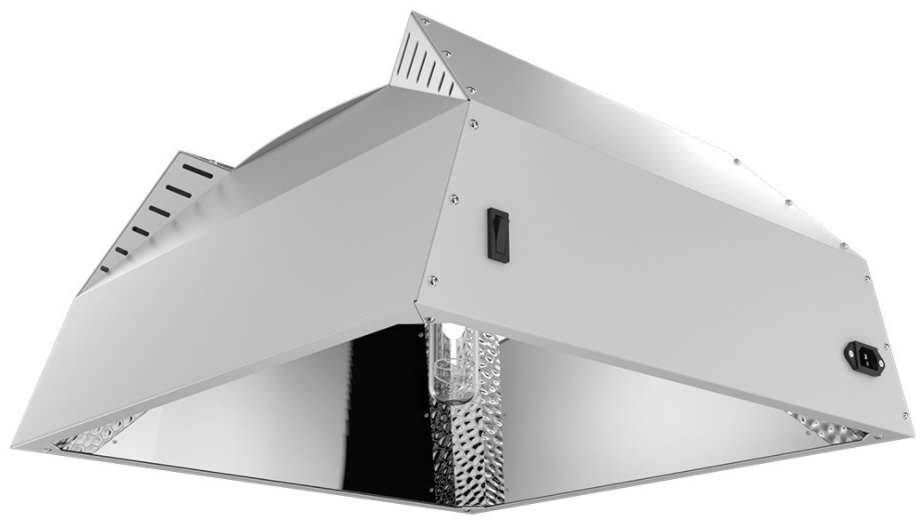
Light emitting ceramics are even more advanced. They use a ceramic arc like HPS bulbs but operate like halide lights. They last longer than metal halide and HPS lights. Their light spectrum is similar to natural light, ideal for both vegetable growth and flowering.
The downsides of these artificial grow lights are that you can only use magnetic ballasts and their cost. These are expensive and nowhere within my inventory of grow lights to tell you the truth. These are more for industrial purposes unless you just have the money, these are a good option.
Another negative aspect of these light emitting ceramics is the fact that they put out UV light. Other lights come with warnings that you shouldn’t look into them for risk of burning your retinas. These have that risk as well as the risk that they’ll cause sunburn. Wear long sleeves as well as UV-blocking sunglasses if you are considering using these lights.
Sulphur plasma grow lights resemble natural light, including putting out the bright light sun-loving plants will thrive under. The problem is that they can’t be put close to plants. These lights could be used at the top of high-ceiling grow rooms or greenhouses.
A good thing about these lights is that they are long-lasting. If you’re using them in a grow tent, they need to be high up because they could literally heat the tent if not burn it. On the downside, Plasma grow lights tend to be very expensive and because of this they are usually used for industrial purposes.
Additional Resources
The Importance Of Lighting To Indoor Plants

As a hardcore indoor gardener I want the best for my indoor babies. I would imagine that you do too if you really care for your indoor garden. One of the aspects of indoor gardening that you cannot get away from is lighting for your plants. From seedlings to mature adult plants, botany life cannot live without proper light.
If you are a beginner and would like to know more about lighting in general you can read my post on the Top 4 Indoor Gardening Tips that Every Beginner Should Know.
What Are The Signs Of A Good Grow Light
The best grow lights share several characteristics, if I can put it that way. The first one is that they generate light at the frequencies that support plant growth at whatever phase you want to foster. In this regard, bright lights don’t matter as much as lights that put out more red light to accelerate leaf growth and vegetative phase growth along with some blue light for strong stems and overall plant health.
The overall luminosity matters, especially if growing sun-loving plants, but there’s a point where you can have too much. You need grow lights that will put out the energy you need without too much heat, since that can dry out or burn plants. The ideal grow lights will put out light but barely any heat, since this is correlated to good energy efficiency.
Well made grow lights such as the Galaxyhydro 300W have simple hardware where you get both the lights and everything you need to mount it and run it in one box. The ideal grow lights let you plug them in to the wall and be done, instead of having to figure out where to put cables, how to connect fans and whether or not you can plug in timers and reflectors.
There is one reason why we can’t say there is one perfect grow lamp, and that is the fact that the best grow lights for your situation depend on the application. Different grow lights provide differing coverage areas and are often designed for optimizing growth at specific stages. For that reason, we can recommend several good grow lights but not a single, ideal grow light for every single use case.
300 Watt Grow Light by JHOTEC
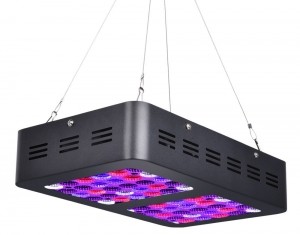 This full spectrum grow light is good for plants in the vegetative stage like seedlings and flowering plants. It mimics natural sunlight except for the UV light. It has both strong light and deeper than average penetration.
This full spectrum grow light is good for plants in the vegetative stage like seedlings and flowering plants. It mimics natural sunlight except for the UV light. It has both strong light and deeper than average penetration.
This particular grow light is energy efficient, and the light gets amplified when you switch between growth or bloom mode (though you can do both at once). This means you could have it put out only red light when encouraging micro-vegetables and seedlings and use less power than a grow light that puts out predominately blue light.
This grow light covers a 2 foot square growing area when two feet above the plants. Its maximum coverage is 3’ square if you have plants that don’t need high intensity light or you’re using the grow light as a supplement to delay blooms.
The Grow Light by JHOTEC comes with built in fans to keep them from overheating. The only downside of these models is the tendency to burn out bulbs rather quickly. Conversely, you can connect them in a daisy chain fashion so you only need a single timer to control a whole series of the lights.
The Current Price and Amazon Rating is listed below:
EnerEco 100 Watt Grow Light Bulb
 This is not a complete grow light per se, but it is bulbs that I have bought to replace burnt out ones. I have to say, they pack a punch. The 100 Watt bulb is designed for almost any application. It is good for seedlings, vegetable growth, hydroponics and greenhouses. It puts out roughly three times as much red light as blue light, fostering leaf growth without resulting in weak plants.
This is not a complete grow light per se, but it is bulbs that I have bought to replace burnt out ones. I have to say, they pack a punch. The 100 Watt bulb is designed for almost any application. It is good for seedlings, vegetable growth, hydroponics and greenhouses. It puts out roughly three times as much red light as blue light, fostering leaf growth without resulting in weak plants.
The EnerEco bulb is energy efficient ad has excellent heat dissipation. Consider this bulb as a good light source for a single large plant or 2’ square area of seedlings. I’ve personally used it as supplementary light for plants receiving natural light to accelerate growth or delay flowering.
Another option would be to use a network of these bulbs in an enclosed area where no natural light gets in. This really comes in handy especially if you are doing your growing in a basement where there are no windows at all. I recommend that you do not handle these bulbs or install them in the socket without proper eye protection.
The Current Price and Amazon Rating is listed below:
GrowLED LED Indoor Garden Light
I remember when I started my indoor gardening endeavors and started using indoor garden lighting I started with something similar to this…(Nostalgia is setting in). This is great for beginners or those just getting started with indoor gardening/hydroponics.
The GrowLED indoor garden light as I mentioned is designed for novices. Its clean, minimalist aesthetic makes it perfect for putting in a windowsill or sitting on the kitchen counter as you grow sprouts, micro-vegetables or herbs.
The broad spectrum white light is safe to put in the open, a strong contrast to other grow lights you can’t risk the kids looking at. However, that doesn’t mean you should stare at the bulbs.
It comes with a timer for 16 hours on and 8 hours off to fuel plant growth. Unfortunately you can’t dim the lights on this unit. According to user reviews it is best that you don’t put it right next to the sink where it could get really wet. Light sprays of water as you mist the plants to maintain the right humidity or splashed water as you do dishes is fine and won’t hurt the electrical parts of the unit.
It seems that the main downside of this unit is that the manufacturer shows the lights as being part of an entire kit when in reality it doesn’t come with pots or containers for the plants which is a bummer to say the least.
The Current Price and Amazon Rating is listed below:
Black Aspect 20W Luxury LED Grow Light
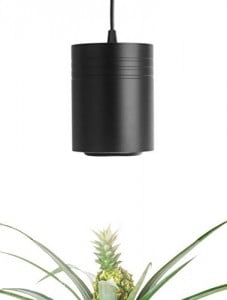 There are times we want grow lights that don’t look like industrial grow lights. In comes the Black Aspect brand luxury grow light. This 20 Watt LED grow light looks like a classic black hanging lamp while it produces supplemental lights for anything from potted plants to dwarf trees.
There are times we want grow lights that don’t look like industrial grow lights. In comes the Black Aspect brand luxury grow light. This 20 Watt LED grow light looks like a classic black hanging lamp while it produces supplemental lights for anything from potted plants to dwarf trees.
This unit is capable of covering a small area suitable for a few small plants or one larger one. One benefit of this model is that it runs cool enough that it doesn’t need a fan, which is perfect for putting in the corner with a plant that needs extra light without looking like an actual grow light. Note, that a 40 watt model is available, and the same grow light comes in white and silver so you can find something that suits your décor.
Seriously, when I saw that someone had actually come up with something like this I knew I had to get one for myself because that would give me the opportunity to have plants growing upstairs without having it look like it. I highly recommend it even though it’s a little pricey. Here’s a picture of my setup with this light.
The Current Price and Amazon Rating is listed below:
Hgrope 14W Indoor Grow Light Bar
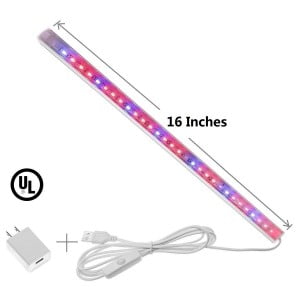 This indoor grow light bar not only is convenient, but is a very affordable way to get several lights in one place without much hassle. The Hgrope Light Bar puts out 20 watts of light and generates red light, blue light and even UV light. It comes with two separate rows of bulbs, each on their own flexible arms.
This indoor grow light bar not only is convenient, but is a very affordable way to get several lights in one place without much hassle. The Hgrope Light Bar puts out 20 watts of light and generates red light, blue light and even UV light. It comes with two separate rows of bulbs, each on their own flexible arms.
These LED grow lights are perfect supplemental lights, since you can position them to help a specific bunch of flowers or any level of the under-layer of any plant.
As I mentioned above you can use them as mobile supplementary light sources as well such as providing some extra light when the autumn summer sun isn’t giving your herb garden enough light or the plants on your desk seem to be suffering.
You can even choose whether to run one or two of the rows of lights. I’ve managed to put about 6 of these together to cover a big area of plants when I first started indoor gardening, but quickly realized that this defeats the purpose of the mobility aspect that these lights were originally made for.
Another cool aspect of these lights is that they intentionally generate heat, making them a good choice as a supplementary light and heat for a single planter if that is all you will be using it for.
The Current Price and Amazon Rating is listed below:
Additional Resources
About Us | Privacy Policy | FTC Disclaimer | Contact Us | Site Map
The owner of this website, Grownindoors.org, is a participant in the Amazon Services LLC Associates Program, an affiliate advertising program designed to provide a means for sites to earn advertising fees by advertising and linking Grownindoors.org Reviews to Amazon properties including, but not limited to, amazon.com, endless.com, myhabit.com, smallparts.com, or amazonwireless.com.
